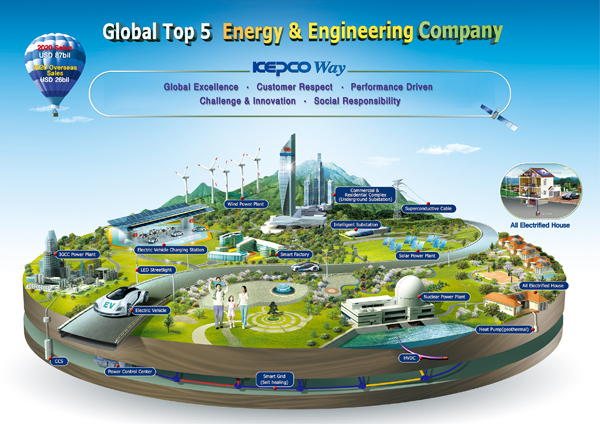[Sponsored Report] A more stable, eco-friendly power system on its way

A computerized image of a smart green city. Provided by Kepco
The Korean government is also preparing to install a nationwide smart grid system. Various related laws and regulations have passed to allow the installation of the new system. Since December 2009, the Jeju test site, the largest in the world, experimented and developed smart grid technologies for 168 companies.
The Korea Electric Power Corporation (Kepco) has worked to develop the smart power grid by researching the consumer base, renewable energy and power supply services in order to test new technologies and develop commercial models.
By conducting tests, Kepco has discovered essential information, such as expected consumer behavior and technical failures. The results of the experiment will help produce a better basic infrastructure for the smart grid.
The key to success of the smart grid system is dispersion of the infrastructure. The new power system cannot operate without supporting facilities such as the Advanced Metering Infrastructure (AMI), which measures and records energy production and consumption, and Energy Storage System (ESS). Kepco has launched an AMI task force to install AMI to 21 million households in Korea by 2020. The company is also preparing to commercialize bulk ESS for general use.
ESS allows a stable supply of electricity by reserving the surplus energy and using it during heavy-demand hours. It could complement the irregular energy production of renewable energy sources such as wind and solar power.
Kepco is currently considering using ESS for amplitude modulation, which runs on thermal power. Replacing thermal power with renewable energy sources will reduce the cost of energy throughout the nation.
In addition, the company is researching how to replace diesel generation with an eco-friendly micro grid system in isolated areas such as islands. The micro grid is an energy supply system for a small area that involves generating, storing and consuming electricity.
On March 13, Kepco hosted a ground-breaking ceremony for building independent energy facilities on Gasa Island in Jindo, South Jeolla. The company plans to complete the installation of the micro grid sytem on the island by October this year and let the island provide its own energy demand.
Kepco’s micro grid system aims to maximize the efficiency of energy use through carefully constructed plans using IT and ESS.
In the case of the Gasa Island project, various energy sources will be applied to the power system to allow reliable electricity production. Various systems such as a 400-kilowatt wind power generator, a 320-kilowatt solar power generator and 3 megawatt-per-hour batteries will support the island. The energy management system will calculate the most efficient cycle for the island’s residents.
According to Kepco, the government can save 16 billion won ($15.6 million) if all of the 120 isolated areas use the micro grid system. The new power system will also solve problems such as the loss of energy from long-distance transmission and the construction of facilities for bulk transmission.
The company is currently testing its micro grid system in Sinan County, South Jeolla, which was installed last year. The results will be used to modify the system. The recognized problems such as the massive initial development cost, lack of related regulations and lack of added values from the system are under thorough research.
The ultimate goal for off-grid areas such as Gasa Island and Sinan County is to generate 99 percent of its energy from renewable sources and cut their budgets for power generation by half. Consequently, carbon emissions from burning coal or diesel would contribute in preserving the environment.
According to Navigant Research, a research firm that studies the global clean technology market, the scale of the micro grid industry will reach $40 billion in 2020. Kepco sees the rise of the micro grid market as an opportunity to be the leader in the global market. The research the company has gathered will give it the competitive edge it needs to be a global leader. Kepco aims to export its micro grid system to other countries in few years.
“When the Gasa Island project is complete, the benefit from replacing diesel power generation such as reduction in the cost and carbon emission will be evident,” said Kim Byung-sook, the head of new growth engine department. “Micro Grid, the compound of renewable energy, ESS and information and communication technology, will lead the energy industry in this creative economy era.”










with the Korea JoongAng Daily
To write comments, please log in to one of the accounts.
Standards Board Policy (0/250자)